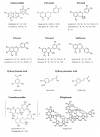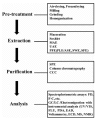Plant phenolics: extraction, analysis and their antioxidant and anticancer properties
- PMID: 20966876
- PMCID: PMC6259146
- DOI: 10.3390/molecules15107313
Plant phenolics: extraction, analysis and their antioxidant and anticancer properties
Abstract
Phenolics are broadly distributed in the plant kingdom and are the most abundant secondary metabolites of plants. Plant polyphenols have drawn increasing attention due to their potent antioxidant properties and their marked effects in the prevention of various oxidative stress associated diseases such as cancer. In the last few years, the identification and development of phenolic compounds or extracts from different plants has become a major area of health- and medical-related research. This review provides an updated and comprehensive overview on phenolic extraction, purification, analysis and quantification as well as their antioxidant properties. Furthermore, the anticancer effects of phenolics in-vitro and in-vivo animal models are viewed, including recent human intervention studies. Finally, possible mechanisms of action involving antioxidant and pro-oxidant activity as well as interference with cellular functions are discussed.
Figures




Similar articles
-
Plant phenolics in the prevention and treatment of cancer.Adv Exp Med Biol. 2010;698:36-51. doi: 10.1007/978-1-4419-7347-4_4. Adv Exp Med Biol. 2010. PMID: 21520702 Review.
-
Role of Phenolic Compounds in Human Disease: Current Knowledge and Future Prospects.Molecules. 2021 Dec 30;27(1):233. doi: 10.3390/molecules27010233. Molecules. 2021. PMID: 35011465 Free PMC article. Review.
-
The Potential of Plant Phenolics in Prevention and Therapy of Skin Disorders.Int J Mol Sci. 2016 Feb 18;17(2):160. doi: 10.3390/ijms17020160. Int J Mol Sci. 2016. PMID: 26901191 Free PMC article. Review.
-
Seaweed-derived phenolic compounds as diverse bioactive molecules: A review on identification, application, extraction and purification strategies.Int J Biol Macromol. 2024 May;266(Pt 1):131147. doi: 10.1016/j.ijbiomac.2024.131147. Epub 2024 Mar 26. Int J Biol Macromol. 2024. PMID: 38537857 Review.
-
Plant Phenolics in the Prevention and Therapy of Acne: A Comprehensive Review.Molecules. 2024 Sep 6;29(17):4234. doi: 10.3390/molecules29174234. Molecules. 2024. PMID: 39275081 Free PMC article. Review.
Cited by
-
Evaluation of the Enzyme Inhibition, Antioxidant, and Antimicrobial Activities of Apricots, Plums, and Their Hybrid Fruits.Plants (Basel). 2024 Oct 20;13(20):2936. doi: 10.3390/plants13202936. Plants (Basel). 2024. PMID: 39458883 Free PMC article.
-
Comparative Evaluation of Conventional and Emerging Maceration Techniques for Enhancing Bioactive Compounds in Aronia Juice.Foods. 2024 Oct 13;13(20):3255. doi: 10.3390/foods13203255. Foods. 2024. PMID: 39456316 Free PMC article.
-
Influence of Harvesting Stage on Phytochemical Composition, Antioxidant, and Antidiabetic Activity of Immature Ceratonia siliqua L. Pulp from Béni Mellal-Khénifra Region, Morocco: In Silico, In Vitro, and In Vivo Approaches.Curr Issues Mol Biol. 2024 Sep 29;46(10):10991-11020. doi: 10.3390/cimb46100653. Curr Issues Mol Biol. 2024. PMID: 39451533 Free PMC article.
-
Waveform Optimization for the In Vitro Detection of Caffeic Acid by Fast-Scan Cyclic Voltammetry.ACS Meas Sci Au. 2024 Jul 31;4(5):534-545. doi: 10.1021/acsmeasuresciau.4c00029. eCollection 2024 Oct 16. ACS Meas Sci Au. 2024. PMID: 39430967 Free PMC article.
-
Streptomyces fradiae Mitigates the Impact of Potato Virus Y by Inducing Systemic Resistance in Two Egyptian Potato (Solanum tuberosum L.) Cultivars.Microb Ecol. 2024 Oct 17;87(1):131. doi: 10.1007/s00248-024-02437-5. Microb Ecol. 2024. PMID: 39419884 Free PMC article.
References
-
- D'Archivio M., Filesi C., Di Benedetto R., Gargiulo R., Giovannini C., Masella R. Polyphenols, dietary sources and bioavailability. Ann. Ist. Super. Sanita. 2007;43:348–361. - PubMed
-
- Manach C., Scalbert A., Morand C., Remesy C., Jimenez L. Polyphenols: food sources and bioavailability. Am. J. Clin. Nutr. 2004;79:727–747. - PubMed
Publication types
MeSH terms
Substances
LinkOut - more resources
Full Text Sources
Other Literature Sources
Medical

